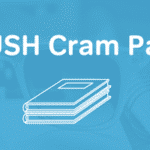
Every learner can benefit from an effective study plan. You know the routine: make flashcards, take quizzes and practice tests, or go over chapter outlines found online. Did you know you can use your APUSH notes to study better? Follow the tips and strategies to help guide your study plan using your APUSH notes.
The most effective note-taking methods vary from person to person. You most likely already utilize a strategy or technique that fits your individual learning style. This post is not about how to take notes, but rather to show you how to convert your existing notes into a useful frame for studying.
Grab your APUSH notes and let’s get started!
How to Use Your APUSH Notes to Study Better
More than likely, your current APUSH notes are substantial. While your notes cover all the information you need, studying straight from your notes is not very effective. There is just too much content! Use the following ideas to help condense copious notes into a few pages of study-worthy material.
Research shows that an optimal study review occurs when the learner “transforms their notes in an interactive way”. Experiment with the following strategies and techniques until you find a good fit for your individual learning style.
The Cornell Note-Taking System
Reframe your notes using the Cornell Note-Taking System in order to analyze and synthesize historical content. Go through your existing notes chapter by chapter. If chapters contain too much information, group your APUSH notes or group by key concept. Use the “record” section to write down main ideas and supporting details.
In the “cue column,” create a list of questions based on your notes. Let the questions highlight sections of your main ideas. For example, how does historical content relate from one main idea to the next? What led up to a historical event taking place? What factors went into a societal change in a certain time period? Try to make your questions open-ended and thought-provoking. Also include facts, key vocabulary or names of integral people and events.
One of the most important steps in the Cornell System is to write a brief summary for each section of information. Make this quick and easy, limiting yourself to 7-8 sentences at most. Summarizing forces you to prioritize information and ideas, such as what concepts are most important and why?
Click for a full image of the Cornell Note-Taking system.
How to use your APUSH notes to study better using the Cornell System:
Reframing your notes using this system allows you to practice making connections across historical content – exactly what APUSH asks you to do during an exam. By challenging yourself to think in this manner, you are developing test-taking thinking skills and strategies.
If you keep going with the Cornell System, there are even more ways to study from your APUSH notes.
- Recite: remember those questions you wrote in the “cue column”? After covering the “record” section, answer your own questions from memory. Say your answers aloud, and take note of which questions you could answer completely, and which you needed more support on.
- Review: although it may get tedious at times, review your Cornell System notes at least once a week. Cornell recommends spending at least 10 minutes per week for best retention of information.
The Mind Mapping Method
Visual aids improve how the brain processes information. There are a variety of graphic organizers available, each with their own way to organize information and help visualize ideas and concepts. One of the best graphic organizers for APUSH notes is called Mind Mapping.
Allowing for visual organization of ideas without necessarily following a rigid structure, mind mapping configures your APUSH notes into an easy to follow framework for studying. GoConqr.com has an example of a mindmap for AP US History.
The idea is pretty straightforward: choose a main idea or concept for your mind map and place it in the center of the page. It could be an entire chapter or thematic unit, or just a key concept from class. From there, begin adding main points and supporting details, key phrases or vocabulary from the center circle.
As you keep adding new ideas, add another branch to your mind map. Add color if possible, keeping the same color for the same strand of ideas. (This helps your brain keep the information organized!)
How to use your APUSH notes to study better using a mind map:
- Create: making your own mind map is extremely beneficial method of studying. The creation of the mind map itself counts as study time – writing the information, deciding which concept goes where, which key details to include – all helps you synthesize and prioritize information. Determining relationships between events/concepts starts building visible relationships between historical content.
- Review: use your mind map(s) as a study guide to reference key ideas and concepts from chapter to chapter. As you move visually through your mind map, ask yourself to mentally describe or list supporting details for each section of the map. Cover certain areas in order to “test” yourself as you review.
Although mind mapping by hand is the most effective, often there just isn’t time to create something from scratch. Consider making a map online, or reviewing a map someone else has already created. A free site such as GoConqr.com provides easy-to-use tools for making your own online mind map, flashcards or quizzes. With over 211 APUSH materials already made, you might be able to find what you are looking for without ever having to create your own!
The Outline Organization
Transform your notes into an outline format. It is easiest to move through your existing notes by chapter, big concept or main idea. Often, APUSH teachers will conduct class by thematic units, so it may be easier to focus on a group of particular lessons rather than an entire chapter.
As you read through your notes, highlight key concepts and main ideas. These are your topic headings for your outline. Underneath each key concept you discover, list supporting details, important events/people, or key vocabulary significant to that concept.
Stick to a traditional outline format (use headings, indented information, labeling with letter or number) so that you can easily read through your outline when complete. Also consider adding color-coding to your outline, such as blue for vocabulary, green for main idea, orange for important people, pink for significant events, so that you can quickly identify sections when studying.
How to use your APUSH notes to study better using an outline:
- Test: use your outline as a study tool to help recall information such as main concept, supporting details, etc. Challenge yourself by only looking at the title of each section while recalling as much content as possible. What do you remember about a particular topic? As you move down the outline, determine which topics you are knowledgeable of and which might need more work.
- Online: while making your own outlines are always best for information recall and memorization, it is ridiculous to ignore the thousands of quality outlines that already exist online. Our five favorite outlines are here, but you can also find many more options through a simple search. Try looking for your specific textbook used in class – many of the top APUSH textbooks offer complete chapter outlines on their website.
Other ways to use your APUSH notes to study better
Go online
Convert your APUSH notes from paper to online using an online note-taking system such as GoodNotes. In addition to regular note-taking capabilities, GoodNote lets you incorporate a variety of visuals to help map information, connect data and plot out relationships between content. Draw shapes, change colors and do all sorts of “fun stuff” to your notes to format a more interactive study outline.
Read your APUSH notes out loud
Just like when mom asked you to read out loud, talking through your notes (even in a whisper voice) helps create a stronger connection to the material. As you read, mark anything that doesn’t make sense, that you need more information on, or any questions that might arise. Also note common vocabulary words or terms that show up frequently throughout the chapter.
Watch our note-taking tips below
Remember to set aside time to study!
The more time you spend using your APUSH notes to self-test and review now, the more likely it will be that you accurately retrieve that information during a test! For more APUSH information, visit our blogs at Magoosh.com.



